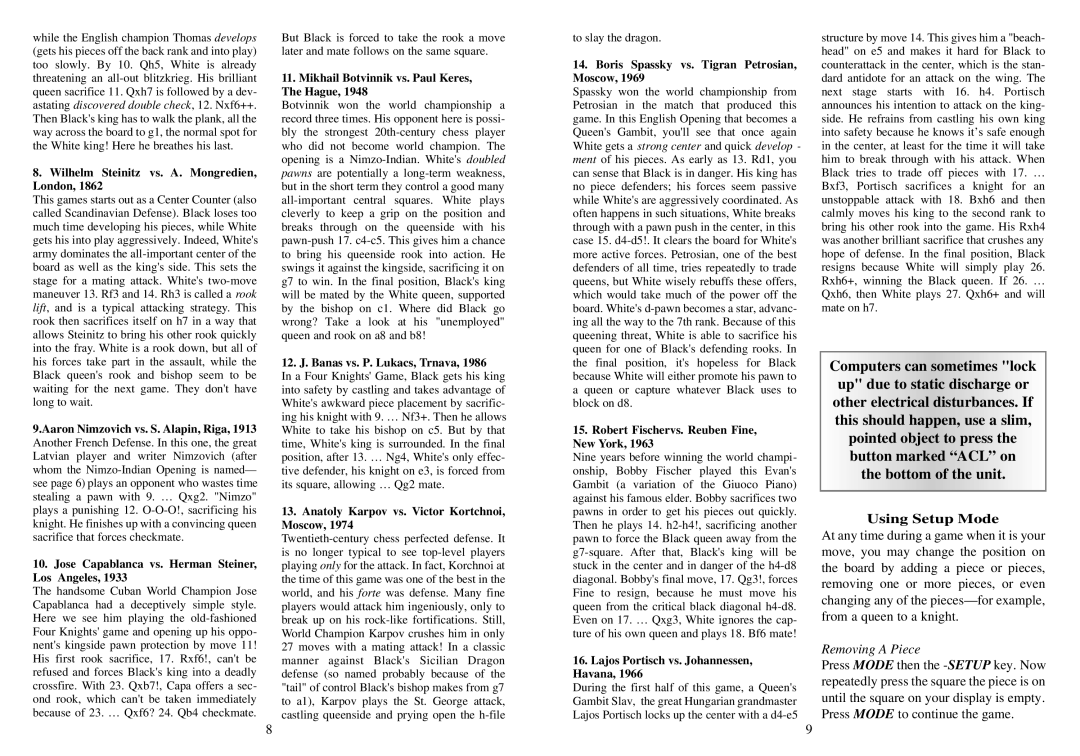
while the English champion Thomas develops (gets his pieces off the back rank and into play) too slowly. By 10. Qh5, White is already threatening an
8.Wilhelm Steinitz vs. A. Mongredien, London, 1862
This games starts out as a Center Counter (also called Scandinavian Defense). Black loses too much time developing his pieces, while White gets his into play aggressively. Indeed, White's army dominates the
9.Aaron Nimzovich vs. S. Alapin, Riga, 1913 Another French Defense. In this one, the great Latvian player and writer Nimzovich (after whom the
10.Jose Capablanca vs. Herman Steiner, Los Angeles, 1933
The handsome Cuban World Champion Jose Capablanca had a deceptively simple style. Here we see him playing the
But Black is forced to take the rook a move later and mate follows on the same square.
11.Mikhail Botvinnik vs. Paul Keres, The Hague, 1948
Botvinnik won the world championship a record three times. His opponent here is possi- bly the strongest
12.J. Banas vs. P. Lukacs, Trnava, 1986
In a Four Knights' Game, Black gets his king into safety by castling and takes advantage of White's awkward piece placement by sacrific- ing his knight with 9. … Nf3+. Then he allows White to take his bishop on c5. But by that time, White's king is surrounded. In the final position, after 13. … Ng4, White's only effec- tive defender, his knight on e3, is forced from its square, allowing … Qg2 mate.
13.Anatoly Karpov vs. Victor Kortchnoi, Moscow, 1974
27moves with a mating attack! In a classic manner against Black's Sicilian Dragon defense (so named probably because of the "tail" of control Black's bishop makes from g7 to a1), Karpov plays the St. George attack, castling queenside and prying open the
to slay the dragon.
14.Boris Spassky vs. Tigran Petrosian, Moscow, 1969
Spassky won the world championship from Petrosian in the match that produced this game. In this English Opening that becomes a Queen's Gambit, you'll see that once again White gets a strong center and quick develop - ment of his pieces. As early as 13. Rd1, you can sense that Black is in danger. His king has no piece defenders; his forces seem passive while White's are aggressively coordinated. As often happens in such situations, White breaks through with a pawn push in the center, in this case 15.
15.Robert Fischervs. Reuben Fine,
New York, 1963
Nine years before winning the world champi- onship, Bobby Fischer played this Evan's Gambit (a variation of the Giuoco Piano) against his famous elder. Bobby sacrifices two pawns in order to get his pieces out quickly. Then he plays 14.
16.Lajos Portisch vs. Johannessen, Havana, 1966
During the first half of this game, a Queen's Gambit Slav, the great Hungarian grandmaster Lajos Portisch locks up the center with a
structure by move 14. This gives him a "beach- head" on e5 and makes it hard for Black to counterattack in the center, which is the stan- dard antidote for an attack on the wing. The next stage starts with 16. h4. Portisch announces his intention to attack on the king- side. He refrains from castling his own king into safety because he knows it’s safe enough in the center, at least for the time it will take him to break through with his attack. When Black tries to trade off pieces with 17. … Bxf3, Portisch sacrifices a knight for an unstoppable attack with 18. Bxh6 and then calmly moves his king to the second rank to bring his other rook into the game. His Rxh4 was another brilliant sacrifice that crushes any hope of defense. In the final position, Black resigns because White will simply play 26. Rxh6+, winning the Black queen. If 26. … Qxh6, then White plays 27. Qxh6+ and will mate on h7.
Computers can sometimes "lock up" due to static discharge or other electrical disturbances. If this should happen, use a slim, pointed object to press the button marked “ACL” on
the bottom of the unit.
Using Setup Mode
At any time during a game when it is your move, you may change the position on the board by adding a piece or pieces, removing one or more pieces, or even changing any of the
Removing A Piece
Press MODE then the
8 | 9 |
